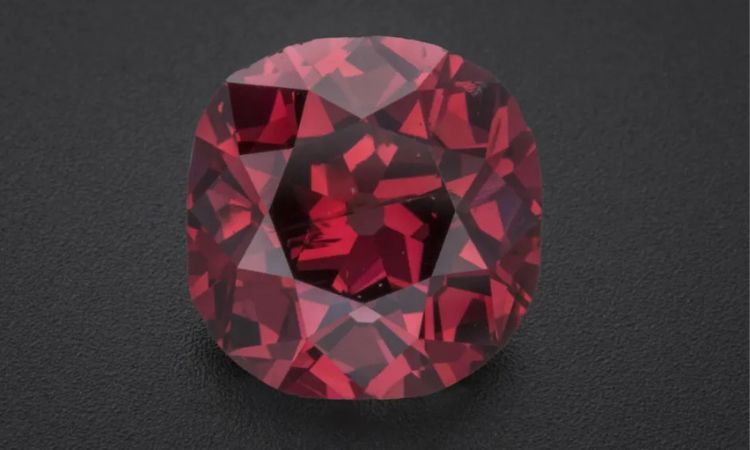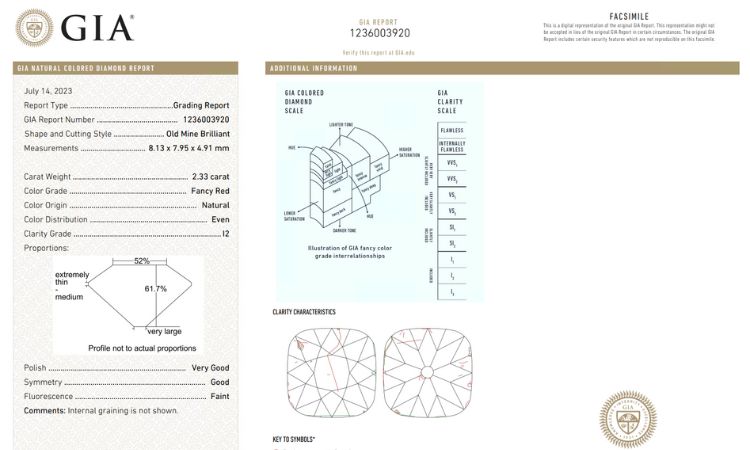The Winston Red Diamond
Diamonds have captured human fascination for centuries, but among these sparkling treasures, red diamonds stand out as some of the rarest and most mysterious gems on Earth. In 2025, the Gemological Institute of America (GIA) had the unique opportunity to examine the Winston Red diamond—an extraordinary 2.33-carat Fancy red diamond, now featured at the Smithsonian's National Museum of Natural History. This monumental occasion has not only added to our understanding of natural fancy colored diamonds but also offered the public a rare chance to witness one of the world's most elusive gemstones.
What Makes Red Diamonds So Rare?
Natural fancy colored diamonds are already rare, but red diamonds are in a league of their own. According to GIA research, out of over a million color diamonds examined, only 0.07% were classified as red—making them the rarest diamond color known to exist.
- Fewer than 24 pure red diamonds over one carat are documented in the public record.
- The Winston Red, at 2.33 carats, is the fifth-largest Fancy red diamond ever recorded and the largest pure red diamond currently on public display.
- In comparison, more than 6,000 blue diamonds have been documented, highlighting the extreme scarcity of red diamonds.
This rarity translates to immense value and global intrigue, with collectors, scientists, and gem enthusiasts alike eager to study and admire such stones.
The Fascinating History of the Winston Red Diamond
The Winston Red diamond has a storied past that stretches across continents and cultures:
- 1938: Sold by the legendary jeweler Jacques Cartier to the Indian Maharaja of Nawanagar.
- It was once set in the renowned Ceremonial Necklace of Nawanagar, worn during royal events.
- Eventually acquired by Harry Winston, Inc., it became part of the prestigious Winston Fancy Color Diamond Collection.
- 2025: The diamond went on public display at the Smithsonian, as part of a new exhibit featuring 40 other gems from the Winston collection.
This journey has only enhanced the diamond's mystique, linking it to both royal heritage and world-class jewelry houses.

GIA’s Groundbreaking Examination of the Winston Red
The Gemological Institute of America, renowned for its rigorous diamond research and grading standards, played a pivotal role in unlocking the secrets of the Winston Red. In collaboration with the Smithsonian and Harry Winston, GIA scientists conducted a detailed analysis to answer key questions:
How Does a Diamond Become Red?
Unlike blue or pink diamonds, which owe their color to trace elements or structural impurities, red diamonds get their hue from a unique phenomenon:
- Plastic Deformation: GIA determined the Winston Red's vibrant color is due to plastic deformation in its crystal structure. This means that as the diamond was forming deep within the Earth, intense pressure caused slight distortions in the crystal lattice, resulting in the absorption of green light and the emergence of a pure red color.
- Such conditions are exceptionally rare and unpredictable, explaining why so few red diamonds have ever been found.
Origin and Geological Clues
By studying the diamond's mineralogical characteristics, GIA researchers hypothesized that the Winston Red likely originated from either Brazil or Venezuela—regions known for producing rare and unusual diamonds.
This research not only enriches the diamond's story but also helps scientists trace the geological processes that create such extraordinary gems.
Inside the Smithsonian Exhibit: A Showcase of Rarity
On April 1, 2025, the Smithsonian's National Museum of Natural History unveiled an unprecedented display: the Winston Fancy Color Diamond Collection. The exhibit features 41 exceptional gems, with the Winston Red as its dazzling centerpiece.
- The Winston Red is now the largest pure red diamond on public display worldwide.
- The exhibit offers visitors a rare opportunity to observe a spectrum of fancy colored diamonds, highlighting their diversity, complexity, and beauty.
- Educational materials and interactive displays explain the science behind fancy colored diamonds and the meticulous work of gemologists.
This exhibit not only celebrates the artistry of nature but also the achievements of gemological science, inspiring curiosity and awe in all who visit.
The Significance of GIA’s Collaboration and Research
The GIA's partnership with the Smithsonian and Harry Winston, Inc. represents a model for scientific collaboration in the world of high-value gemstones. Through shared expertise and advanced technology, researchers are able to:
- Authenticate and document the world’s rarest diamonds
- Advance our understanding of diamond formation and color origins
- Preserve gemological heritage for future generations
This ongoing research benefits collectors, museums, and the broader public by ensuring that legendary stones like the Winston Red are thoroughly studied, protected, and appreciated.
Why Are Red Diamonds So Valuable?
The value of red diamonds is driven by several factors:
- Extreme rarity: With only 24 red diamonds over one carat known to exist, demand far outstrips supply.
- Pure color: The Winston Red’s uniform, vivid hue makes it especially desirable among collectors and investors.
- Historical provenance: Its royal and high-profile ownership adds to its allure.
- Scientific intrigue: Each red diamond offers unique insights into Earth’s geological history.
For these reasons, red diamonds consistently achieve record prices at auction and remain treasures of both the jewelry market and natural history.
What Collectors and Enthusiasts Can Learn from the Winston Red
The story of the Winston Red diamond offers valuable lessons for anyone interested in rare gemstones:
- Scientific Certification is Crucial: Always look for diamonds graded and certified by respected laboratories such as the GIA.
- Provenance Adds Value: A gemstone’s history can significantly impact its market value and desirability.
- Market Rarity Drives Demand: Understanding rarity metrics helps collectors make informed investment decisions.
- Education Enhances Appreciation: Learning about diamond formation, color origins, and scientific analysis deepens one’s connection to these natural wonders.
Frequently Asked Questions About Red Diamonds
How many red diamonds are there in the world?
Fewer than 24 pure red diamonds over one carat are documented in the public record, making them the rarest of all colored diamonds.
What causes the red color in diamonds?
The red color is caused by plastic deformation—a distortion in the diamond’s crystal lattice during its formation, which alters the way light is absorbed and reflected.
Where do most red diamonds come from?
Red diamonds have been found in a few locations, with Brazil and Venezuela being likely sources for the Winston Red based on GIA’s mineralogical analysis.
What is the largest red diamond on public display?
The Winston Red, at 2.33 carats, is currently the largest pure red diamond on view to the public anywhere in the world.
Can I see the Winston Red in person?
Yes, the Winston Red is part of the Winston Fancy Color Diamond Collection at the Smithsonian's National Museum of Natural History, open to visitors from April 1, 2025 onward.
Conclusion: A Gemstone for the Ages
The GIA’s examination of the Winston Red diamond has shone a spotlight on one of Earth’s rarest natural treasures. As the fifth-largest Fancy red diamond ever discovered—and the largest on public display—its story intertwines scientific discovery, royal heritage, and the enduring allure of colored diamonds. Thanks to collaborative research and public exhibitions, the world can now share in the wonder of the Winston Red, deepening our appreciation for the extraordinary beauty and mystery of natural gems.
Whether you are a gem collector, a student of geology, or simply someone who admires rare beauty, the Winston Red diamond offers inspiration and fascination for generations to come.








Comments (0)
Write your review